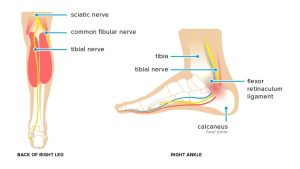Tarsal tunnel Syndrome
The tarsal tunnel is located on the inside of the ankle, and is formed by the ankle bones and the band of ligaments that stretches across the

Morton’s neuroma is a thickening of the tissue that surrounds the small nerve leading to the toes. It occurs as the nerve passes under the ligament connecting metatarsal bones in the forefoot (front part of the foot).
Morton’s neuroma most frequently develops between the third and fourth toes. It often occurs in response to irritation, trauma, or excessive pressure, and is more common in women.

The exact cause is unknown. Doctors believe the following may play a role in the development of this condition:
Symptoms
Symptoms may include:
In rare cases, nerve pain occurs in the space between the 2nd and 3rd toes. This is not a common form of Morton neuroma, but symptoms and treatment are similar.
Exams and Tests
Your health care provider can usually diagnose this problem by examining your foot. Squeezing your forefoot or toes together bring on the symptoms.
A foot x-ray may be done to rule out bone problems. MRI or ultrasound can successfully diagnose the condition.
Nerve testing (electromyography) cannot diagnose Morton neuroma. But it may be used to rule out conditions that cause similar symptoms.
Blood tests may be done to check for inflammation-related conditions, including certain forms of arthritis.
Treatment
Nonsurgical treatment is tried first. Your provider may recommend any of the following:
When to use Physical Therapy in Morton’s neuroma?
Morton’s neuroma Physical Therapy should be considered in the following circumstances:
Outlook (Prognosis)
Nonsurgical treatment does not always improve symptoms. Surgery to remove the thickened tissue is successful in most cases.
Possible Complications
Complications may include:
Avoid ill-fitting shoes. Wear shoes with a wide toe box or flat heels.
Morton neuralgia; Morton toe syndrome; Morton entrapment; Metatarsal neuralgia; Plantar neuralgia; Intermetatarsal neuralgia; Interdigital neuroma; Interdigital plantar neuroma; Forefoot neuroma
McGee DL. Podiatric procedures. In: Roberts JR, Custalow CB, Thomsen TW, eds. Roberts & Hedges’ Clinical Procedures in Emergency Medicine and Acute Care. 7th ed. Philadelphia, PA: Elsevier; 2019:chap 51.
Shi GG. Morton’s neuroma. In: Frontera WR, Silver JK, Rizzo TD Jr, eds. Essentials of Physical Medicine and Rehabilitation: Musculoskeletal Disorders, Pain, and Rehabilitation. 4th ed. Philadelphia, PA: Elsevier; 2019:chap 91.
The tarsal tunnel is located on the inside of the ankle, and is formed by the ankle bones and the band of ligaments that stretches across the
Morton’s neuroma is a thickening of the tissue that surrounds the small nerve leading to the toes. It occurs as the nerve passes under the
What is Motor Neuron Disease? The motor neuron diseases (MNDs) are a group of progressive neurological disorders that destroy cells that control essential muscle activity
Whiplash is a neck injury caused by sudden movement of head. It is commonly happened during car driving because of rear-end car accidents. But whiplash can also
The thoracic outlet is basically a small area, the space between your collarbone and your first rib & vertebrae. Thoracic outlet syndrome is a group
Pelvic Floor The pelvic floor is made up of several muscles, ligaments and tissues that surround the pelvic bone and support that rectum like a
